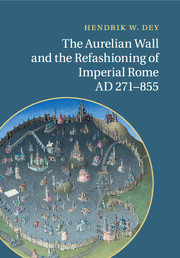Book contents
- Frontmatter
- Contents
- List of abbreviations
- List of figures
- Acknowledgements
- Introduction
- 1 Toward an architectural history of the Aurelian Wall, from its beginnings through the ninth century
- 2 Planning, building, rebuilding, and maintenance: the logistical dynamics of a (nearly) interminable project
- 3 Motives, meaning, and context: the Aurelian Wall and the late Roman state
- 4 The city, the suburbs, and the Wall: the rise of a topographical institution
- 5 Sacred geography, interrupted
- 6 The Wall and the “Republic of St. Peter”
- Conclusion
- Appendices
- Bibliography
- Index
Introduction
Published online by Cambridge University Press: 19 May 2011
- Frontmatter
- Contents
- List of abbreviations
- List of figures
- Acknowledgements
- Introduction
- 1 Toward an architectural history of the Aurelian Wall, from its beginnings through the ninth century
- 2 Planning, building, rebuilding, and maintenance: the logistical dynamics of a (nearly) interminable project
- 3 Motives, meaning, and context: the Aurelian Wall and the late Roman state
- 4 The city, the suburbs, and the Wall: the rise of a topographical institution
- 5 Sacred geography, interrupted
- 6 The Wall and the “Republic of St. Peter”
- Conclusion
- Appendices
- Bibliography
- Index
Summary
What's in a wall? From 1961 until 1989, an ugly and otherwise unprepossessing ribbon of reinforced concrete was the embodiment of a divided planet; an “Iron Curtain” dividing two halves of a city that had once been whole, making two countries out of one, and two worlds where previously there had been many; a manmade terminator between two hemispheres that soon became known simply as “East” and “West.” Another wall remains the only artificial feature ever claimed to be visible from the Moon, an assertion whose utter mythicality only increases its suggestiveness: the “Great Wall of China” is neither a single wall, nor is any of it visible to the unaided human eye from the Moon, yet its legend continues to grow in a technological age inclined more frequently to the systematic evisceration of myth and legend than to their proliferation. In North America, proposals to build a continuous wall between Mexico and the United States to impede the passage of illegal immigrants into the latter have repeatedly driven the Mexican government to the brink of apoplexy.
At the beginning of the third millennium, another wall has come to make world headlines. A squat and utilitarian thing assembled from various prefabricated materials (concrete, chain-link fencing, barbed wire, and so on), this barrier has been erected on the initiative of the Israeli government for the stated purpose of curtailing the movements of militants living and operating within predominantly Palestinian areas of settlement, around and through which its several sections make their unsubtle way.
- Type
- Chapter
- Information
- Publisher: Cambridge University PressPrint publication year: 2011
- 1
- Cited by



